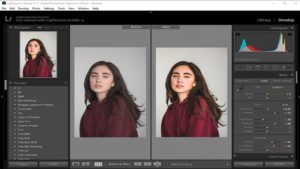Top 5 Lightroom Photo Editing Tips For Beginners
When I initially opened Lightroom, I was overpowered by every one of the sliders, modules, capacities, and all the other things it has to bring to the table.
Yet, Lightroom is an incredible piece of programming with regards to altering computerized photographs. So dominating it is a colossal advance towards making proficient quality pictures.
Nobody can gain proficiency with all of Lightroom in a solitary article, so all things considered, I made this rundown of Lightroom tips for novices so you can begin the correct way and ideally stay away from a portion of the missteps I made when I previously began.
Start by taking notes about how you alter a photograph. I do this by keeping a little notebook close to my PC. You don’t have to record everything about it. Monitor the nuts and bolts.
Over the long run, you’ll find that you will, in general, make similar changes following numerous pictures. Check out that propensity.
- Is it an impact you like?
- Is it helping your photographs, generally speaking?
- What will happen if you adopt an alternate strategy?
Responding to these inquiries will assist you with distinguishing your favored work process and afterward challenge you to improve it.
When you see an example created, see that example to check whether you are moving toward those alters in the best request. A few enhancements work better right off the bat (like openness or white equilibrium), and some are best left to the end (like honing and commotion decrease).
Having a strong work process and framework for altering your photographs is by a long shot the main component of good photograph changing in Lightroom. I share my whole work process in this course. Note; keep in mind our valuable lightroom photo editing tips and bookmark this page for next purposes.
Lightroom Tips For Beginners Step By Step
01.Cull Your Photos Aggressively
“Winnowing” your photographs is the interaction by which you pick the attendants and reject them. Part of the magnificence of advanced photography is that you can take numerous photos and investigate with different lighting, stances, and pieces without burning through cash on film. The drawback is that you can wind up with multiple terrible shots to go through toward the finish of the shoot.
In any case, having the option to remove the terrible pictures is critical to make great photography. Few out of every odd thought will be a masterpiece .And unquestionably, only one out of every bizarre photograph should be altered and posted on the web! Be condemning of your work. Hold yourself to an exclusive requirement. Note; keep in mind our valuable lightroom photo editing tips and bookmark this page for next purposes.
When you winnow your pictures, don’t be reluctant to dispose of a considerable lot of the photographs. Try not to stress. You don’t need to erase them in Lightroom. Utilize the “Pick” and “Reject” banners. The actual thought will remain on your hard drive. However, then you can channel down to take a gander at the ones you picked. (I typically return after about a year and erase every one of the oddballs from my hard drive. If I didn’t require them the entire year, I wouldn’t at any point need them)
Separating your pictures allows you to zero in on the best ones and give them the time and consideration you need to draw out the best in those pictures. Note; keep in mind our valuable lightroom photo editing tips and bookmark this page for next purposes.
02.Use presets
It very well might be a dubious assessment, yet presets can be an extraordinary learning instrument whenever utilized accurately. As a fledgling with Lightroom, you presumably realize how every one of the sliders and organizations deals with your photographs. You may have a thought in your brain about how you need an image to look and have no clue about how to arrive.
That is the place where Lightroom presets can prove to be useful. Most very much planned will permit you to get a specific look at your photographs with a solitary snap. Note; keep in mind our valuable lightroom photo editing tips and bookmark this page for next purposes.
In any case, you can borrow something more profound than that and after you utilize the preset, investigate the changes that the maker used to make that look. At that point, you can explore different avenues regarding comparable settings on those equivalent changes and figure out what they mean for your photograph.
03.Start With White Balance
White equilibrium is the primary thing I do on pretty much every picture. There is an explanation that it’s at the highest point of the entire board of Lightroom Classic when you’re altering.
By guaranteeing that you start with the right white equilibrium, you will have a lot simpler time with your altars pushing ahead. Note; keep in mind our valuable lightroom photo editing tips and bookmark this page for next purposes.
I recommend trying not to utilize the white equilibrium sliders to add imaginative shading reviewing to your pictures, to begin with (additional about coming up). It starts with a benchmark white equilibrium that gives you the right tones, particularly regarding individuals’ skin tones in the picture.
Having an exact shading picture, which you need to begin with, permits you to explore different avenues regarding distinctive shading, reviewing however much you need while continually having a benchmark picture to return to them. I’ve additionally tracked down that imaginative shading reviewing appears to look better when you have an “accurately” hued print to work from it.
04.Learn To Control Color
Shading reviewing is something that novices regularly forget about. You might be asking why I isolated this from white equilibrium. White equilibrium is about shading. Note; keep in mind our valuable lightroom photo editing tips and bookmark this page for next purposes.
For the most part, when somebody alludes to shading reviewing, they mean utilizing shading to make an imaginative “look” to the picture. It is somewhat not the same as the white equilibrium, which is more about building up the benchmark of the “valid” shade of the image.
I believe it’s critical to view them as independent. It will be ideal if you utilize white equilibrium to address your picture to get skin tone looking exact. When you have that pattern to work from, you can use different instruments in Lightroom to add an inventive shading grade.
My number one Lightroom device for adding an imaginative shading grade is the Split Toning board. Note; keep in mind our valuable lightroom photo editing tips and bookmark this page for next purposes.
Split conditioning permits you to add a shading tone to the features and an alternate shade to the shadows. At that point, you can change the immersion of everyone to make the look you need. You can likewise utilize the “Equilibrium” slider to change where Lightroom splits among features and shadows.
While Split Toning isn’t close to as exact or incredible as the instruments in Photoshop, it is a direct and basic approach to test and figure out how to shading grade your pictures.
05.Recover Highlights and Shadows
While we discuss features and shadows, we should speak a little about recuperating the detail in those spaces. In pretty much every picture I take, I raise the radiance of the shadows and lower the features’ glow. Note; keep in mind our valuable lightroom photo editing tips and bookmark this page for next purposes.
Present-day cameras are quite astonishing and can catch a wide scope of glow (we call this “unique reach”). Be that as it may, most screens and prints where the pictures you can show have a more modest reach.
So that implies you’ll frequently need to ease up the shadows and obscure the features. You can recuperate a portion of the detail here and guarantee that the end watcher can see that detail. You might not need to do this on EVERY picture, except you should know about and consider each shot.
Clipping path benefits at Clipping Path Specialist
Since most distributing programming manages everything far removed from cutting, this is helpful for visual planners. It is because it works for them. They can toss your item photographs against some other picture or foundation without managing a white foundation. Aside from these, it permits the content to contort against the first item.
Clipping path service specialists provide services:
- Clipping path
- Background removal
- Image masking
- Drop shadow
- Ghost mannequin
I would say this is against the limits of your rectangular picture. On the off chance that you intend to keep some print material, the section way is significantly more fundamental for you. Additionally, a solitary picture results from numerous courses in the photograph business for various things with colors. Note; keep in mind our valuable lightroom photo editing tips and bookmark this page for next purposes. !!
Keyword: Lightroom photo editing Tips
Meta: Do you want to learn Lightroom photo editing Tips? Get into this article and learn basic tips for beginners.


